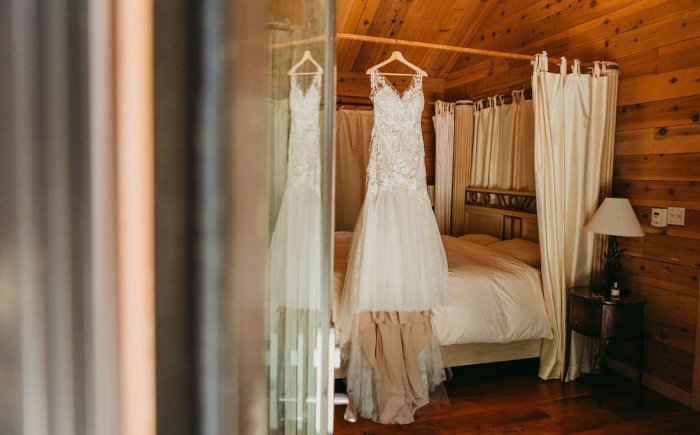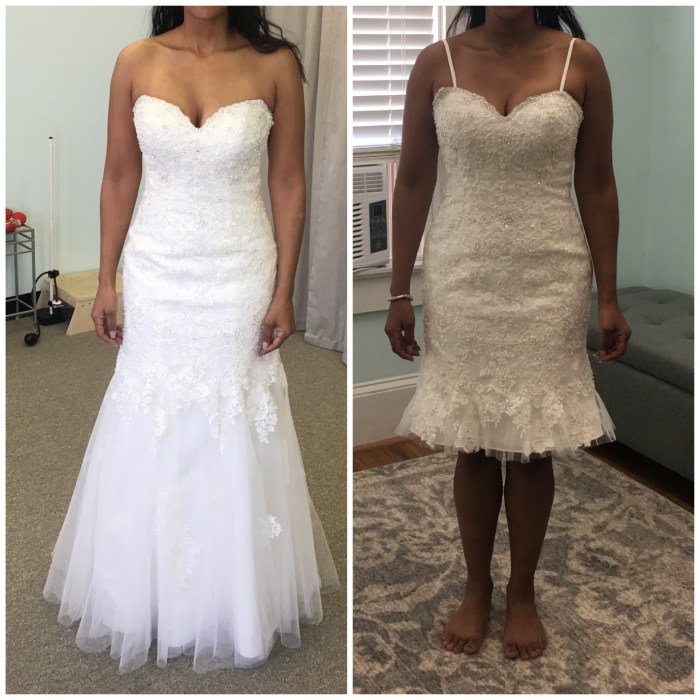What to Make Out of Old Wedding Dress
Repurposing Your Wedding Dress: A Creative Guide
What to make out of old wedding dress – Your wedding dress, a symbol of a cherished day, doesn’t have to languish in a box. This guide offers various creative avenues to repurpose its beautiful fabrics and embellishments, transforming a cherished memory into something new and meaningful.
Repurposing the Fabric
Wedding dresses utilize a variety of fabrics, each with unique properties impacting their suitability for different projects. Understanding these characteristics is crucial for successful repurposing.
Common wedding dress fabrics include lace, satin, silk, tulle, and organza. Lace, with its delicate intricacy, is ideal for smaller projects requiring detailed embellishment. Satin, known for its smooth sheen, works well in garments and home decor requiring a luxurious feel. Tulle, a lightweight netting, is versatile for various applications, while organza, a sheer fabric, adds elegance and texture.
| Fabric Type | Suitable Projects | Advantages | Disadvantages |
|---|---|---|---|
| Lace | Blouses, handkerchiefs, bridal accessories, decorative trim | Intricate detail, luxurious feel | Delicate, can be difficult to sew |
| Satin | Skirts, dresses, pillowcases, decorative accents | Smooth, lustrous finish, drapes well | Can be slippery to sew, prone to snagging |
| Tulle | Skirts, overlays, veils, decorative accents | Lightweight, airy, versatile | Can be difficult to manage, prone to fraying |
| Organza | Overlays, embellishments, decorative accents | Sheer, elegant, adds texture | Can be difficult to sew, easily wrinkled |
Before repurposing, carefully clean the fabric. Hand washing with a mild detergent is generally recommended for delicate fabrics. Allow the fabric to air dry completely, away from direct sunlight to prevent discoloration. Pressing with a low heat iron, using a pressing cloth, helps to remove wrinkles and prepare the fabric for cutting and sewing.
When cutting and sewing, use sharp scissors to ensure clean cuts. Employ small, sharp needles and a fine thread suitable for the fabric type. Consider using a walking foot on your sewing machine for even feeding, especially with delicate materials. Take your time and work slowly, especially around intricate details.
Creating New Garments, What to make out of old wedding dress
Transforming your wedding dress into a new garment allows you to retain the beauty of the original while adapting it to your current style. This process involves careful planning, creative design, and skilled sewing techniques.
For example, a classic A-line wedding dress could be transformed into a chic cocktail dress by shortening the length, altering the neckline, and adding modern sleeves. The original fabric’s luxurious feel and embellishments will add a unique touch.
- A flowing skirt, utilizing the bottom portion of the dress.
- A stylish bolero jacket, repurposing the bodice.
- A sophisticated blouse, incorporating the lace or embellishments.
- A charming dress for a special occasion, using the entire gown.
- A practical tote bag, using the fabric scraps and embellishments.
Repurposing a pre-existing garment presents challenges, such as working with seams and pre-existing alterations. Careful planning, precise cutting, and skillful seam ripping are essential to overcome these obstacles. Understanding the original construction is crucial for successful adaptation.
The aesthetic contrast between the original wedding dress and the new garment will depend on the design choices. A formal wedding dress might become a casual summer dress, showcasing a transformation from traditional elegance to modern simplicity.
Home Decor and Accessories

Source: wixstatic.com
Wedding dress fabric lends itself beautifully to home decor projects. Its luxurious texture and delicate details can add a touch of elegance and personalization to your living space.
Pillows, blankets, and wall hangings are just a few possibilities. A unique piece could be a framed section of lace, showcasing intricate details, or a decorative pillow featuring the original train of the wedding dress. This requires careful planning and execution to highlight the fabric’s beauty.
Repurposing an old wedding dress offers exciting possibilities; you could create stunning heirloom pieces or even donate the fabric to a charity. If you’re looking for inspiration, consider the elegant tailoring often seen in a wedding reception dress for groom , which might offer ideas for transforming your old dress into something equally sophisticated. Ultimately, the possibilities are only limited by your imagination and sewing skills.
Creating a decorative item from lace or embellishments involves careful removal of the desired elements from the dress. Clean the elements gently, and then use them to adorn a simple item, like a plain cushion cover or a picture frame. This can create a personalized, sentimental keepsake.
Preserving the fabric in its new home decor application requires careful handling and cleaning. Avoid harsh chemicals and abrasive cleaning methods. Regular dusting and gentle spot cleaning will help maintain the fabric’s appearance and extend its lifespan.
Sentimental Keepsakes

Source: weddingbee.com
Transforming your wedding dress into keepsakes allows you to preserve cherished memories in a tangible and meaningful way. This process combines creativity with sentimentality, creating items that hold lasting emotional value.
A quilt made from squares of the dress fabric, each representing a specific moment or aspect of the wedding, would be a treasured heirloom. A framed piece of embroidery, featuring the initials of the couple or a significant date, would be a subtle yet poignant reminder. A keepsake box, lined with the dress fabric and adorned with embellishments, could store precious mementos.
The emotional significance of repurposing a wedding dress into keepsakes is profound. It helps in transitioning from the wedding day to the next chapter of life, transforming a symbol of a past event into something new and meaningful, connecting the past to the present.
Donation and Upcycling
Donating your wedding dress offers an alternative to repurposing, providing a sustainable and socially responsible way to give back to the community.
Before donation, clean the dress thoroughly. Contact local charities or organizations that accept wedding dress donations for reuse or recycling. Some organizations specialize in providing wedding dresses to brides who cannot afford them, while others use the fabric for other creative projects.
Donating versus repurposing offers different benefits. Donation provides immediate assistance to those in need, while repurposing allows for creative expression and personalized keepsakes. From an environmental perspective, both options are better than discarding the dress in a landfill, reducing textile waste.
Questions and Answers: What To Make Out Of Old Wedding Dress
Can I use a damaged wedding dress for repurposing?
Yes, depending on the extent of the damage. Minor tears or stains can often be repaired or incorporated into the design. However, severely damaged fabric may be unsuitable for certain projects.
How do I preserve the color of the fabric when repurposing?
Pre-treating the fabric with a color-safe cleaner and avoiding harsh detergents during cleaning will help preserve the color. Additionally, storing the finished project away from direct sunlight will prevent fading.
What if I’m not a skilled sewer?
Many projects are suitable for beginners, such as creating simple pillows or blankets. You can also find numerous tutorials online or consider seeking help from a local seamstress for more complex projects.
What is the best way to clean a wedding dress before repurposing?
Professional dry cleaning is generally recommended to remove stains and preserve the fabric. Always follow the care instructions on the dress label.
















